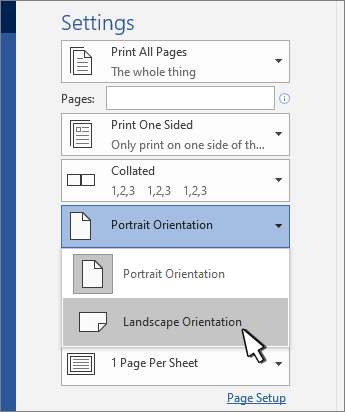
- #How to apply landscape orientation in word 2013 how to
- #How to apply landscape orientation in word 2013 pdf
So the next time you open this file, it will appear in portrait view.

Rename the file and choose the location to save it. To permanently save the current view for future reference, select File from the menu bar and click Save As.Ĥ. The page orientation will change from landscape to portrait view. Leave all other settings as they are and click the OK button.ģ. In this example, select Counterclockwise 90 degrees. Select the suitable option from the Direction dropdown list to rotate the page to the view that you want. Select Document from the menu bar and click Rotate Pages.Ģ.
#How to apply landscape orientation in word 2013 pdf
So how do you permanently change the orientation of a PDF page? Follow these simple steps:ġ. When you close this file and reopen it the next time, the page view will still appear in landscape. By using the method above, i.e., View –> Rotate View –> Clockwise or Counterclockwise, it will temporarily change the page view to portrait. As an example, the original page opens up in a landscape view, but you want to change it to portrait view.

However, if you close the file and reopen it at a later time, you will be looking at the original orientation of the page and not the view that you have previously changed. To learn more about that, see the next video in this course, Use landscape and portrait in the same document.It is easy to change the view of a page in your PDF file, and most of us will select View –> Rotate View –> Clockwiseor Counterclockwise. You can create a document with a mix of portrait and landscape pages. Just be prepared to spend some time on reworking the layout. So, when you consider all the factors that go into choosing a frame for your document, it makes sense to choose an orientation before you start.īut if you want to change later, you can. You get a really wide frame, which works great with a wide table, but it is too wide for text.įinally, you need to consider how all the different types of elements work together.Īfter spending a lot of time carefully, laying out your document in portrait orientation, switching to landscape could turn everything to scrambled eggs. For example, if you are on the PAGE LAYOUT tab, click Size, and change to Legal size paper. So you need to consider Margins as well as Orientation when you are deciding on a frame for your document.Īlso, the size of the paper is a factor. You can change to Wide again to move the 2-inch margins back to the side, but the document doesn’t look same in landscape. The 2-inch side margins move 90 degrees to the top and bottom.

Now, watch what happens when we click Orientation and Landscape to switch to landscape.

On the PAGE LAYOUT tab, let’s click Margins and choose Wide to give the document a nice sparse look with 2-inch side margins. So you can think of page orientation as a way to change the frame or container where your document sits in.īut there are other things that determine your document’s frame, too. So as you work on a document, you can switch between the two orientations any time you want to see which one looks best with your content.Īnd when you do, Word automatically moves everything to fit on the pages. This is what it looks like when you print a landscape page. Now with more horizontal space, you can adjust the column widths to give your table more breathing room. And the content in the document turns 90 degrees. Go to the PAGE LAYOUT tab, click Orientation, and Landscape. This is what it looks like when you print a portrait page.īut if your document contains something that is essentially horizontal, like tables with a lot of columns, you can change the orientation to landscape. By default, a document uses portrait orientation, because most documents are primarily text, and text works well in this vertical format.
#How to apply landscape orientation in word 2013 how to
When you are deciding how to frame a picture, you use a vertical or portrait orientation for things like portraits and other vertically-oriented subjects.Īnd you use a horizontal or landscape orientation for horizontal subjects, like a landscape.


 0 kommentar(er)
0 kommentar(er)
